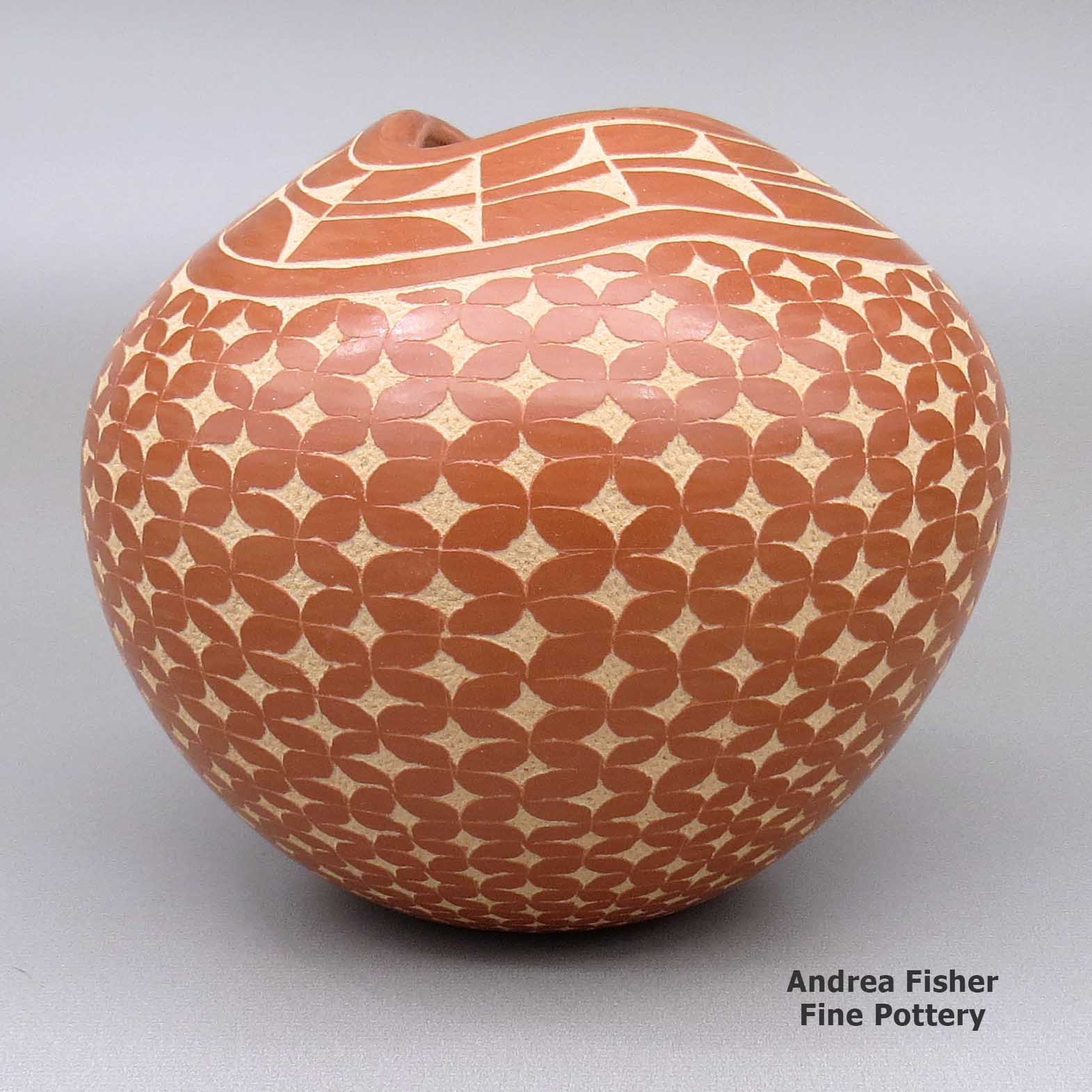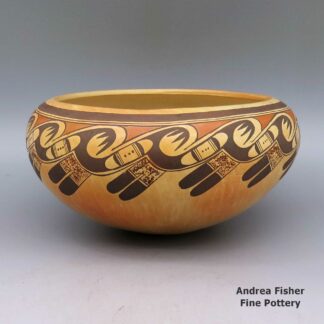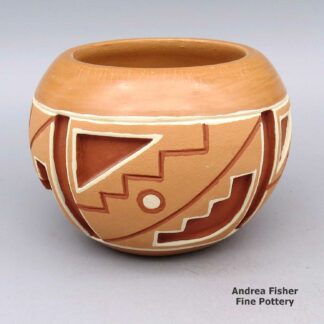| Dimensions | 5 × 5 × 4.75 in |
|---|---|
| Condition of Piece | Excellent |
| Date Born | 2022 |
| Signature | Carol Vigil Jemez |
Carol Vigil, zzje2m231, Red bowl with sgraffito geometric design
$275.00
A red bowl with an organic opening and decorated with a sgraffito geometric design
In stock
Brand
Vigil, Carol
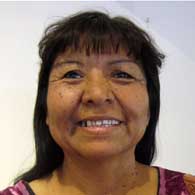 Carol Vigil was born into Jemez Pueblo in March of 1960. Her mother, aunt and grandmother were potters but Carol didn't really get into the clay until she was in her twenties.
Carol Vigil was born into Jemez Pueblo in March of 1960. Her mother, aunt and grandmother were potters but Carol didn't really get into the clay until she was in her twenties.Carol says a turning point in her life came when Maria Martinez died. That was when she put her hands in clay and truly felt strength and encouragement flowing into her from the clay. Then she got serious and studied with her grandmother, Julia Baca, and her aunt, Persingula Gachupin.
Over the years Carol has participated in the Santa Fe Indian Market, Heard Museum Indian Market in Phoenix and Colorado Indian Market in Denver. Some of her pieces are in the Smithsonian Collection in Washington DC. She's gone home from the Santa Fe Indian Market with two Best in Category ribbons and a Best in Division ribbon.
Carol's favorite pottery shape to work with is the vase, usually red and polished, then decorated with bands of traditional and contemporary sgraffito daisy designs.
When not making pottery, Carol is a family advocate and works with victims of domestic violence and their children. She is busy, working hard to keep families together and in safe environments. She says that when it gets to be too much, she turns to the clay for strength and relaxation. Working with clay renews her body and mind as she is a caring and passionate person. Perhaps you can feel that when you see and touch her pottery...
A Short History of Jemez Pueblo

As the drought in the Four Corners region deepened in the late 1200s, several clans of Towa-speaking people migrated southeastward, across the Upper San Juan River into the Gallina Highlands, then over the hill to the Canyon de San Diego area in the southern Jemez mountains. Other clans of Towa-speaking people migrated southwest and settled in the Jeddito Wash area in northeastern Arizona, below Antelope Mesa and southeast of Hopi First Mesa. The large migrations out of the Four Corners area began around 1250 and the area was almost entirely depopulated by 1300. The Towa-speakers who went southeast were pretty much settled by about 1350.
Archaeologist Jesse Walter Fewkes argues that pot sherds found in the vicinity of the ruin at Sikyátki (near the foot of Hopi First Mesa) speak to the strong influence of earlier Towa-speaking potters on what became "Sikyátki Polychrome" pottery (Sikyátki was a village at the foot of First Mesa, destroyed by other Hopis around 1625). Fewkes maintained that Sikyátki Polychrome pottery was the finest ceramic ware ever made in prehistoric North America.
Francisco de Coronado and his men arrived in the Jemez Mountains of Nuevo Mexico in 1539. By then the Jemez people had built several large masonry villages among the canyons and on some high ridges in the area. Their population was estimated at about 30,000 and they were among the largest and most powerful tribes in northern New Mexico. Some of their pueblos reached five stories high and contained as many as 3,000 rooms.

Because of the nature of the landscape they inhabited, agriculture was hard. The Jemez had always been travelers and traders. Their people had traded goods all over the Southwest and northern Mexico for generations. In those days they also made a lot of pottery and trading pottery with Zia and Santa Ana Pueblos for food was a brisk business.
The arrival of the Spanish was disastrous for the Jemez and they resisted the Spanish with all their might. That led to many atrocities against the tribe until they rose up in the Pueblo Revolt of 1680 and helped evict the Spanish from northern New Mexico. With the Spanish gone, the Jemez destroyed much of what they had built on Jemez land. Then they concentrated on preparing themselves for the eventual return of the hated priests and the Spanish military.
The Spanish returned in 1692 and their efforts to retake northern New Mexico bogged down as the Jemez fought them doggedly for four years. In 1696 many Jemez came together, killed a Franciscan missionary and then fled to join their distant relatives in the Jeddito Wash area in northeastern Arizona. They remained at Jeddito Wash for several years before returning to the Jemez Mountains.
It was around that time that the Hopi themselves destroyed Awatovi, the largest pueblo in the Hopi area (many of the people of Awatovi also spoke Towa). A Spanish missionary with a few soldiers had appeared at Awatovi in 1696 and forced the rebuilding of the mission. He also started getting people into the church. The leader of Awatovi went to the other Hopi pueblos and told their leaders that his people had strayed too far: they must be destroyed to cleanse the Earth of their sins. In the winter of 1700-1701, men from Walpi, Oraibi and a couple other pueblos invaded Awatovi while the men were in their kivas. The invaders pulled the ladders out of the kivas, poured baskets of hot red chile peppers and burning pine pitch down, then killed almost everyone. When the frenzy was over they burned the pueblo down and salted the earth around it so it would never be reoccupied.
On their return to the Jemez Mountains around 1700, the Jemez people built the pueblo they now live in (Walatowa: The Place) and made peace with the Spanish authorities. Even today, there are still strong ties between the Jemez and their cousins on Dineh territory at Jeddito.
East of what is now Santa Fe is where the ruins of Pecos Pueblo (more properly known as Cicuyé) are found. Cicuyé was a large pueblo housing up to 2,000 people at its height. The people of Cicuyé were the easternmost speakers of the Towa language in the Southwest. After the Pueblo Revolt, the Pecos area fell on increasingly hard times (constant Apache and Comanche raids, European diseases, increasing drought). The pueblo was finally abandoned in 1838 when the last 17 residents relocated to Jemez. The Governor of Jemez welcomed them and allowed them to retain many of their Pecos tribal offices (governorship and all). Members of former Pecos families still return to the site of Cicuyé every year to perform religious ceremonies in honor of their ancestors.

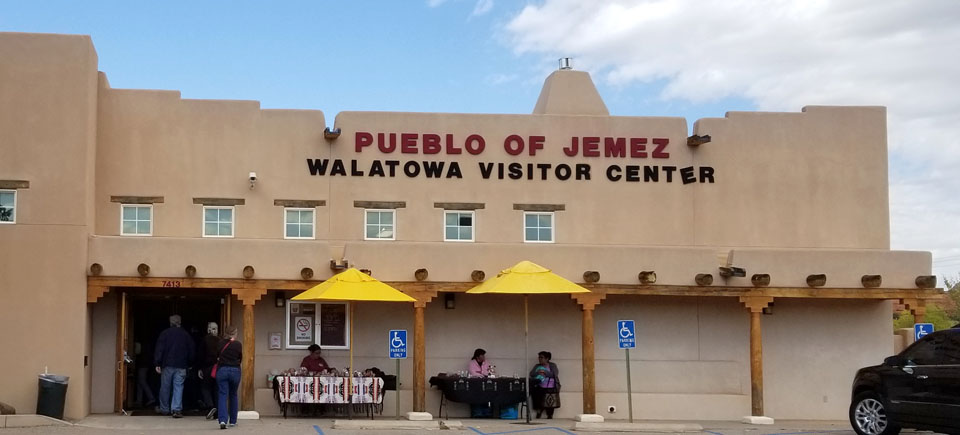

For more info:
Pueblos of the Rio Grande, Daniel Gibson, ISBN-13:978-1-887896-26-0, Rio Nuevo Publishers, 2001
Prehistoric Hopi Pottery Designs, Jesse Walter Fewkes, ISBN-0-486-22959-9, Dover Publications, Inc., 1973
Photos are our own. All rights reserved.
About Bowls
The bowl is a basic utilitarian shape, a round container more wide than deep with a rim that is easy to pour or sip from without spilling the contents. A jar, on the other hand, tends to be more tall and less wide with a smaller opening. That makes the jar better for cooking or storage than for eating from. Among the Ancestral Puebloans both shapes were among their most common forms of pottery.
Most folks ate their meals as a broth with beans, squash, corn, whatever else might be in season and whatever meat was available. The whole village (or maybe just the family) might cook in common in a large ceramic jar, then serve the people in their individual bowls.
Bowls were such a central part of life back then that the people of the Classic Mimbres society even buried their dead with their individual bowls placed over their faces, with a "kill hole" in the bottom to let the spirit escape. Those bowls were almost always decorated on the interior (mostly black-on-white, color came into use a couple generations before the collapse of their society and abandonment of the area). They were seldom decorated on the exterior.
It has been conjectured that when the great migrations of the 11th, 12th, 13th and 14th centuries were happening, old societal structures had to change and communal feasting grew as a means to meet, greet, mingle with and merge newly arrived immigrants into an already established village. That process called for larger cooking vessels, larger serving vessels and larger eating bowls. It also brought about a convergence of techniques, styles, decorations and design palettes as the people in each locality adapted. Or didn't: the people in the Gallina Highlands were notorious for their refusal to adapt and modernize for several hundred years. They even enforced a No Man's Land between their territory and that of the Great Houses of Chaco Canyon, killing any and all foreign intruders. Eventually, they seem to have merged with the Towa as those people migrated from the Four Corners area to the southern Jemez Mountains.
Traditional bowls lost that societal importance when mass-produced cookware and dishware appeared. But, like most other Native American pottery in the last 150 years, market forces caused them to morph into artwork.
Bowls also have other uses. The Zias and the Santo Domingos are known for their large dough bowls, serving bowls, hair-washing bowls and smaller chili bowls. Historically, these utilitarian bowls have been decorated on their exteriors. More recently, they've been getting decorated on the interior, too.
The bowl has also morphed into other forms, like Marilyn Ray's Friendship Bowls with children, puppies, birds, lizards and turtles playing on and in them. Or Betty Manygoats' bowls encrusted with appliqués of horned toads or Reynaldo Quezada's large, glossy black corrugated bowls with custom ceramic black stands.
When it comes to low-shouldered but wide circumference ceramic pieces (such as many Sikyátki-Revival and Hawikuh-Revival pieces are), are those jars or bowls? Conjecture is that the shape allows two hands to hold the piece securely by the solid body while tipping it up to sip or eat from the narrower opening. That narrower opening, though, is what makes it a jar. The decorations on it indicate that it is more likely a serving vessel than a cooking vessel.
This is where our hindsight gets fuzzy. In the days of Sikyátki, those potters used lignite coal to fire their pieces. That coal made a hotter fire than wood or manure (which wasn't available until the Spanish brought it). That hotter fire required different formulations of temper-to-clay and mineral paints. Those pieces were perhaps more solid and liquid resistant than most modern Hopi pottery is: many Sikyátki pieces survived intact after being slowly buried in the sand and exposed to the desert elements for hundreds of years. Many others were broken but were relatively easy to reassemble as their constituent pieces were found all in one spot and they survived the elements. Today's pottery, made the traditional way, wouldn't survive like that. But that ancient pottery might have been solid enough to be used for cooking purposes, back in the day.
About Geometric Designs
"Geometric design" is a catch-all term. Yes, we use it to denote some kind of geometric design but that can include everything from symbols, icons and designs from ancient rock art to lace and calico patterns imported by early European pioneers to geometric patterns from digital computer art. In some pueblos, the symbols and patterns denoting mountains, forest, wildlife, birds and other elements sometimes look more like computer art that has little-to-no resemblance to what we have been told they symbolize. Some are built-up layers of patterns, too, each with its own meaning.
"Checkerboard" is a geometric design but a simple black-and-white checkerboard can be interpreted as clouds or stars in the sky, a stormy night, falling rain or snow, corn in the field, kernels of corn on the cob and a host of other things. It all depends on the context it is used in, and it can have several meanings in that context at the same time. Depending on how the colored squares are filled in, various basket weave patterns can easily be made, too.
"Cuadrillos" is a term from Mata Ortiz. It denotes a checkerboard-like design using tiny squares filled in with paints to construct larger patterns.
"Kiva step" is a stepped geometric design pattern denoting a path into the spiritual dimension of the kiva. "Spiral mesa" is a similar pattern, although easily interpreted with other meanings, too. The Dineh have a similar "cloud terrace" pattern.
That said, "geometric designs" proliferated on Puebloan pottery after the Spanish, Mexican and American settlers arrived with their European-made (or influenced) fabrics and ceramics. The newcomers' dinner dishes and printed fabrics contributed much material to the pueblo potters design palette, so much and for so long that many of those imported designs and patterns are considered "traditional" now.


